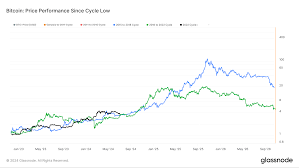
Bitcoin, the pioneering cryptocurrency, has seen a remarkable journey since its inception. Understanding its market performance over time provides valuable insights into its evolution, volatility, and the factors driving its value. Here’s a detailed look at Bitcoin’s market performance from its early days to the present.
- Bitcoin’s Birth and Early Days (2009-2012) 🍼📅
a. Inception and Initial Value 🌱
Launch Date: Bitcoin was introduced by an anonymous person or group known as Satoshi Nakamoto in January 2009.
Initial Value: In the early days, Bitcoin had negligible monetary value. The first recorded Bitcoin transaction was in 2010, where 10,000 BTC were used to purchase two pizzas for $25, which would be worth millions today.
b. Early Market Development 📈
First Exchanges: Bitcoin began trading on early exchanges like Mt. Gox in 2010. The price started at a fraction of a cent and slowly increased.
Price Milestones: By 2011, Bitcoin’s price reached $1, and it surged to around $30 by mid-year before falling to $2. This volatility set the stage for Bitcoin’s unpredictable market behavior.
- Growth and Increasing Adoption (2013-2016) 🚀📊
a. First Major Bull Run 📈
2013 Surge: Bitcoin’s price exploded to over $1,000 by late 2013, driven by increasing media coverage and growing public interest.
Volatility and Correction: The price experienced a sharp correction after peaking, highlighting Bitcoin’s tendency for dramatic fluctuations.
b. Institutional Interest and Market Expansion 💼🌍
Regulatory Scrutiny: Increased attention from regulators and financial institutions began to shape Bitcoin’s market landscape.
Expanding Ecosystem: The launch of Bitcoin futures trading and investment products in 2015-2016 signaled growing institutional interest and credibility.
- The Surge and Institutionalization (2017-2020) 📈🏦
a. The 2017 Bull Market 📈
Price Surge: Bitcoin’s price skyrocketed to nearly $20,000 in December 2017. This was fueled by widespread media hype and speculative trading.
Market Correction: Following the peak, Bitcoin faced a significant downturn, with prices falling to around $3,000 by early 2018, reflecting its characteristic volatility.
b. Institutional Involvement and Adoption 🏛️🌐
Mainstream Adoption: Institutional investments and the approval of Bitcoin ETFs (Exchange-Traded Funds) in various countries contributed to a more stable and mature market.
Price Recovery: By late 2020, Bitcoin experienced another surge, driven by growing acceptance among institutional investors and major companies, reaching new all-time highs.
- Recent Trends and Current Performance (2021-Present) 🌟📈
a. All-Time Highs and New Milestones 🌐
2021 Peak: Bitcoin reached its all-time high of approximately $69,000 in November 2021. This was driven by increased institutional investment, global economic uncertainties, and growing mainstream adoption.
Market Volatility: Since the peak, Bitcoin has experienced fluctuations, reflecting broader market trends and regulatory developments.
b. Regulatory Developments and Institutional Adoption ⚖️📊
Regulatory Landscape: Ongoing regulatory scrutiny continues to impact Bitcoin’s market performance. Regulations vary significantly across different countries, influencing market dynamics.
Institutional Integration: Major financial institutions and corporations have increasingly integrated Bitcoin into their portfolios, further legitimizing its role in the financial system.
- Factors Influencing Bitcoin’s Market Performance 🔍
a. Market Sentiment 😃📉
Impact of News: Bitcoin’s price is highly sensitive to news and market sentiment, including regulatory announcements, technological advancements, and macroeconomic factors.
b. Technological Developments 🚀💻
Upgrades and Innovations: Technological improvements, such as the implementation of the Lightning Network and scalability solutions, play a crucial role in Bitcoin’s market performance and adoption.
c. Economic Factors 💵🌍
Global Economic Conditions: Economic instability, inflation concerns, and changes in traditional financial markets can drive demand for Bitcoin as a store of value.
- Conclusion 🔄🌟
Bitcoin’s market performance has been marked by remarkable growth, significant volatility, and increasing institutional interest. From its humble beginnings to its current status as a major financial asset, Bitcoin’s journey reflects the broader evolution of the cryptocurrency market. Understanding its historical performance provides valuable insights into its future potential and ongoing market trends. 🚀💡
Whether you’re a long-term investor or a newcomer to the crypto world, staying informed about Bitcoin’s past and present performance can guide your decisions and help you navigate the ever-evolving landscape of digital currencies.






